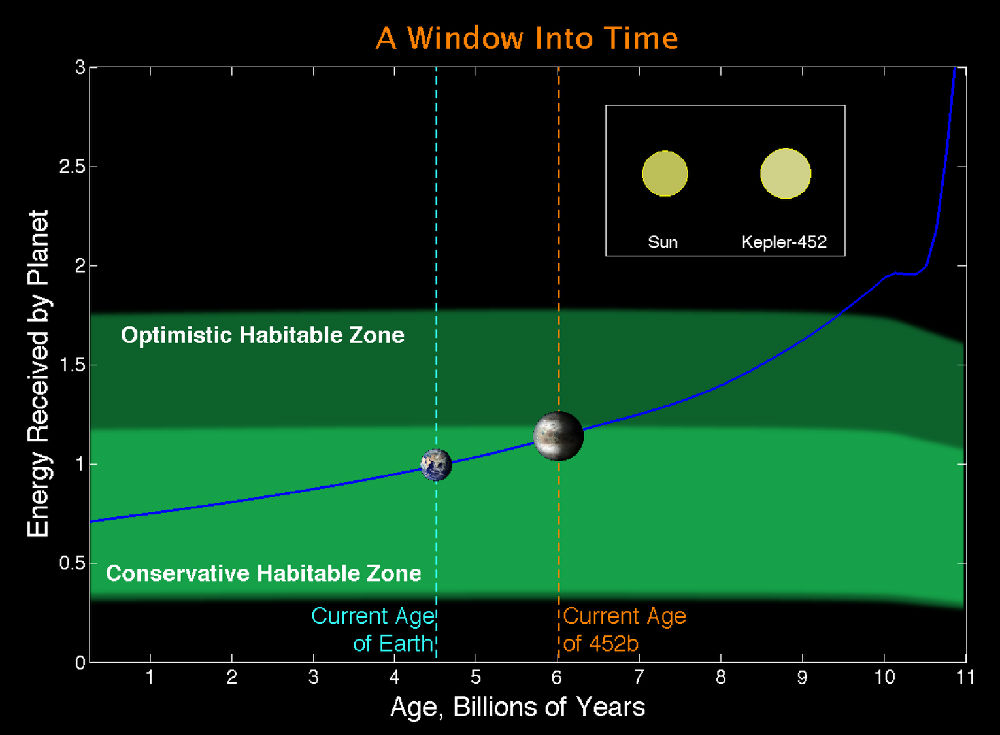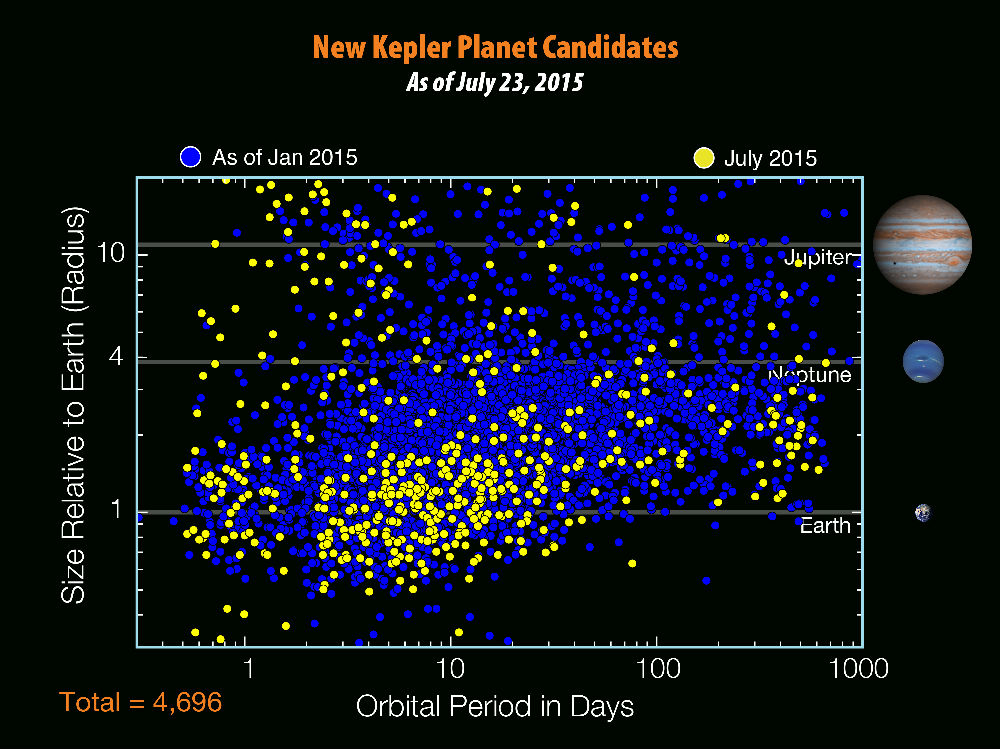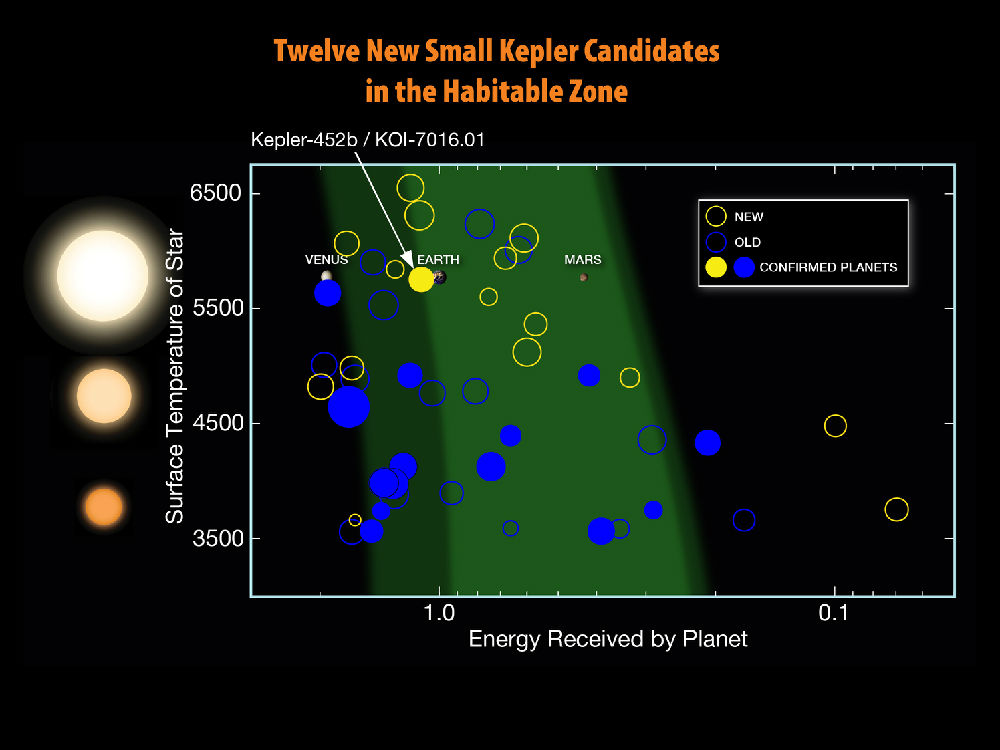博文
Kepler 452b: NASA发现的地球“表兄弟”
|||
Kepler 452b: NASA发现的地球“表兄弟”
诸平

NASA's Kepler mission
据美国宇航局网站(NASA)2015年7月23日消息,天文学家确认发现首颗位于“宜居带”上体积最接近地球大小的行星,代号为“开普勒-452b”(Kepler 452b),这是人类在寻找另一颗地球的道路上的重要里程碑。“开普勒-452b”的发现使已确认系外行星的数量增加到1030颗。“开普勒-452b”距离地球1400光年,其直径约为地球的1.6倍。天文学家确认发现首颗位于“宜居带”上体积最接近地球的行星,围绕一颗类似太阳的恒星运行。


The sweep of NASA Kepler mission’s search for small, habitable planets in the last six years. The first planet smaller than Earth, Kepler-20e, was discovered in December 2011 orbiting a Sun-like star slightly cooler and smaller than our sun every six days. But it is scorching hot and unable to maintain an atmosphere or a liquid water ocean. Kepler-22b was announced in the same month, as the first planet in the habitable zone of a sun-like star, but is more than twice the size of Earth and therefore unlikely to have a solid surface. Kepler-186f was discovered in April 2014 and is the first Earth-size planet found in the habitable zone of a small, cool M dwarf about half the size and mass of our sun. Kepler-452b is the first near-Earth-Size planet in the habitable zone of a star very similar to the sun.
Credits: NASA Ames/W. Stenzel
Searching for Habitable Worlds

This size and scale of the Kepler-452 system compared alongside the Kepler-186 system and the solar system. Kepler-186 is a miniature solar system that would fit entirely inside the orbit of Mercury. The habitable zone of Kepler-186 is very small compared to that of Kepler-452 or the sun because it is a much smaller, cooler star. The size and extent of the habitable zone of Kepler-452 is nearly the same as that of the sun, but is slightly bigger because Kepler-452 is somewhat older, bigger and brighter. The size of the orbit of Kepler-452b is nearly the same as that of the Earth at 1.05 AU. Kepler-452b orbits its star once every 385 days.
Credits: NASA/JPL-CalTech/R. Hurt
Kepler-452 and the Solar System

Since Kepler launched in 2009, twelve planets less than twice the size of Earth have been discovered in the habitable zones of their stars. These planets are plotted relative to the temperature of their star and with respect to the amount of energy received from their star in their orbit in Earth units. The light and dark shaded regions indicate the conservative and optimistic habitable zone. The sizes of the blue disks indicate the sizes of these exoplanets relative to one another and to the image of Earth, Venus and Mars, placed on this diagram for reference. Note that all the exoplanets discovered up until now are orbiting stars which are somewhat to significantly cooler and smaller than the sun. Kepler-452b is the first planet less than twice the size of Earth discovered in the habitable zone of a G-type star.
Credits: NASA Ames/N. Batalha and W. Stenzel

Today Kepler-452b is receiving 10 percent more energy from its parent star than the Earth is from the Sun. If Kepler-452b had the same mass as Earth it would be on the verge of experiencing the runaway greenhouse effect and the loss of its water inventory. However, since it is 60 percent bigger than Earth, it is likely to be approximately five Earth masses, which provides additional protection from the runaway greenhouse effect for another 500 million years. Kepler-452b has spent six billion years in the habitable zone of its star; longer than Earth.
Credits: NASA Ames/J. Jenkins

Twelve Exoplanet discoveries from Kepler that are less than twice the size of Earth and reside in the habitable zone of their host star. The sizes of the exoplanets are represented by the size of each sphere. These are arranged by size from left to right, and by the type of star they orbit, from the M stars that are significantly cooler and smaller than the sun, to the K stars that are somewhat cooler and smaller than the sun, to the G stars that include the sun. The sizes of the planets are enlarged by 25X compared to the stars. The Earth is shown for reference.
Credits: NASA/JPL-CalTech/R. Hurt
A Kepler's Dozen: Small Habitable Zone Planets

There are 4,696 planet candidates now known with the release of the seventh Kepler planet candidate catalog - an increase of 521 since the release of the previous catalog in Jan. 2015. The blue dots show planet candidates from previous catalogs, while the yellow dots show new candidates from the seventh catalog. New planet candidates continue to be found at all periods and sizes due to continued improvement in the detection techniques. Notably, several of these new candidates are near-Earth-sized and at long orbital periods, where they have a chance of being rocky with liquid water on their surface.
Credits: NASA Ames/W. Stenzel
Kepler Planet Candidates, July 2015

Highlighted are new planet candidates from the seventh Kepler planet candidate catalog that are less than twice the size of Earth and orbit in the stars' habitable zone—the range of distances from a star where liquid water could exist on the surface of an orbiting planet. The dark green area represents an optimistic estimate for the habitable zone, while the light green area represents a more conservative estimate for the habitable zone. The candidates are plotted as a function of the star's surface temperate on the vertical axis and by the amount of energy the planet candidate receives by its host star. Open yellow circles show new planet candidates in the seventh catalog. Open blue circles show candidates from previous catalogs. Filled-in circles represent candidates that have been confirmed as planets due to follow-up observations. Note that the new candidates tend to be around stars more similar to the sun, representing progress in finding planets that are similar to the Earth in size and temperature that orbit sun-like stars.
Credits: NASA Ames/W. Stenzel
Twelve New Small Kepler Habitable Zone Candidate

A unique feature of the seventh Kepler candidate catalog is that it is the first to fully automate the assessment of transit-like signals. The total height of each bar shows the total number of Kepler Objects of Interest (KOIs), or transit-like signals, in each catalog. The blue area shows the number that was assessed, which includes all newly found KOIs. The grey area shows the number that were not able to be assessed due to time constraints imposed by manual assessment, which includes KOIs assessed in previous catalogs. As a result of the new automated procedures employed in this seventh catalog, all KOIs could be assessed. The resulting impact is that we are able to deliver a more uniform planet candidate catalog that utilizes the entire Kepler dataset, which will enable more accurate estimates of the number of small habitable zone planets in our galaxy.
Credits: NASA Ames/W. Stenzel and SETI Institute/J. Coughlin

Credits: NASA Ames/W. Stenzel
“宜居带”(habitable zone)是指行星距离恒星远近合适的区域,在这一区域内,恒星传递给行星的热量适中,既不会太热也不太冷,能够维持液态水的存在。开普勒-452恒星系统、开普勒-186恒星系统与太阳系的大小相比较。行星开普勒-452b的轨道半径为1.05个天文单位,几乎与地球到太阳的距离一样,公转周期为385个地球日。“开普勒-452b”位于地球1400光年的“天鹅座”方向,直径只比地球大60%。公转周期为385个地球日,比地球绕太阳一周的时间多出5%。其所围绕的中央恒星无论大小、亮度都与我们太阳非常相似,年龄大约在60亿岁,比太阳大15亿岁。
目前,“开普-452b”的质量和组成还不清楚,根据之前的研究推测,像这样体积的行星是岩石行星的可能性较大,还可能拥有厚厚的大气层和大量的水,还很可能至今仍然有活跃的火山活动。
更多信息请浏览NASA网站相关报道:
Kepler-452b: Earth's Bigger, Older Cousin -- Briefing Materialshttps://blog.sciencenet.cn/blog-212210-907931.html
上一篇:祝卅年学友聚会圆满成功
下一篇:科学家发现控制血压的新受体(附原文)